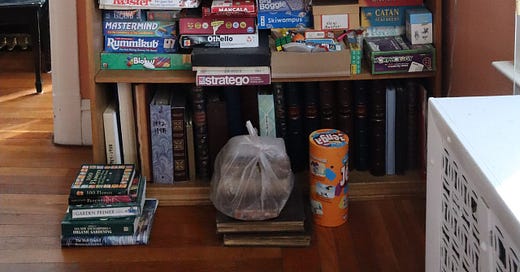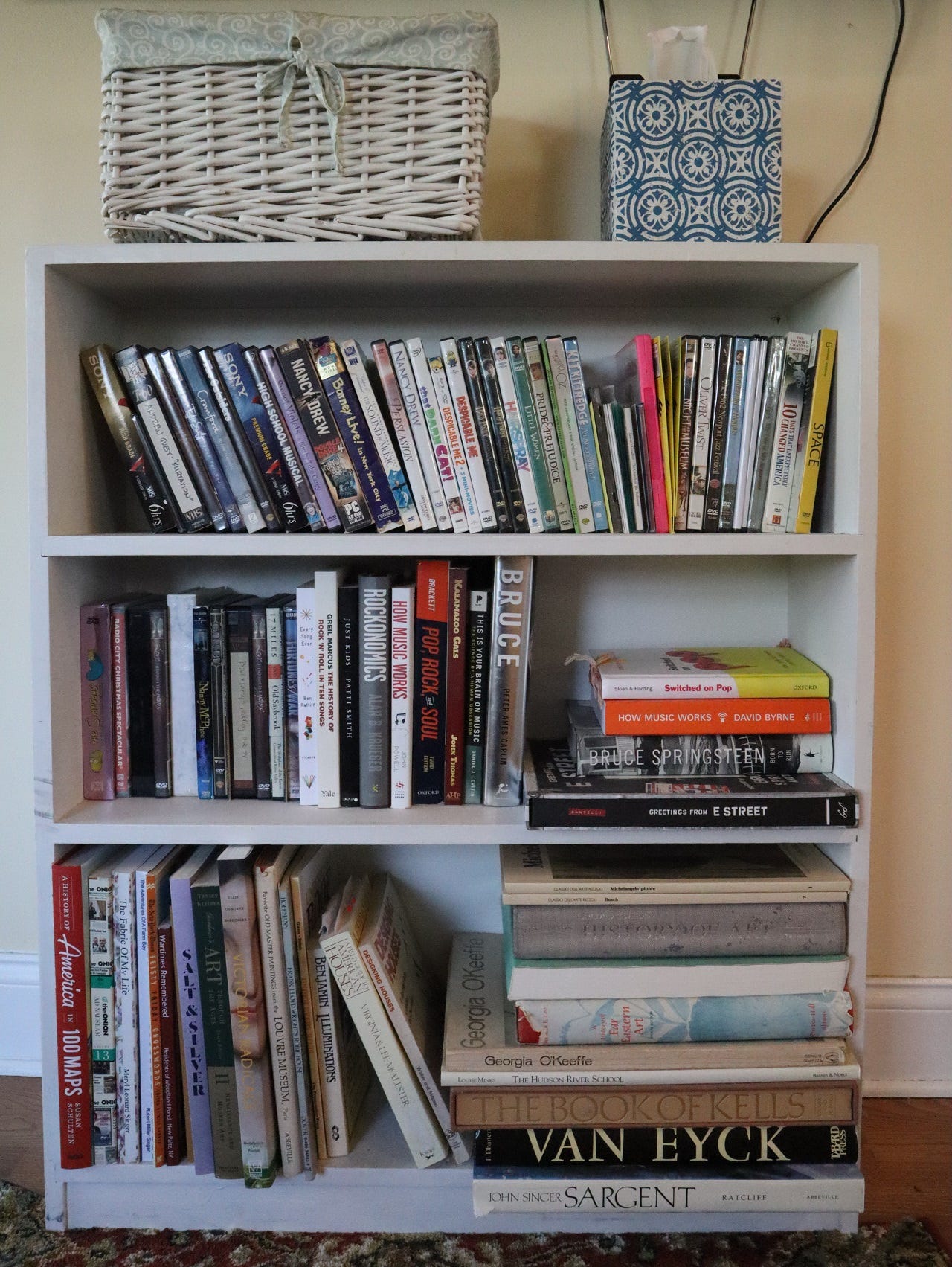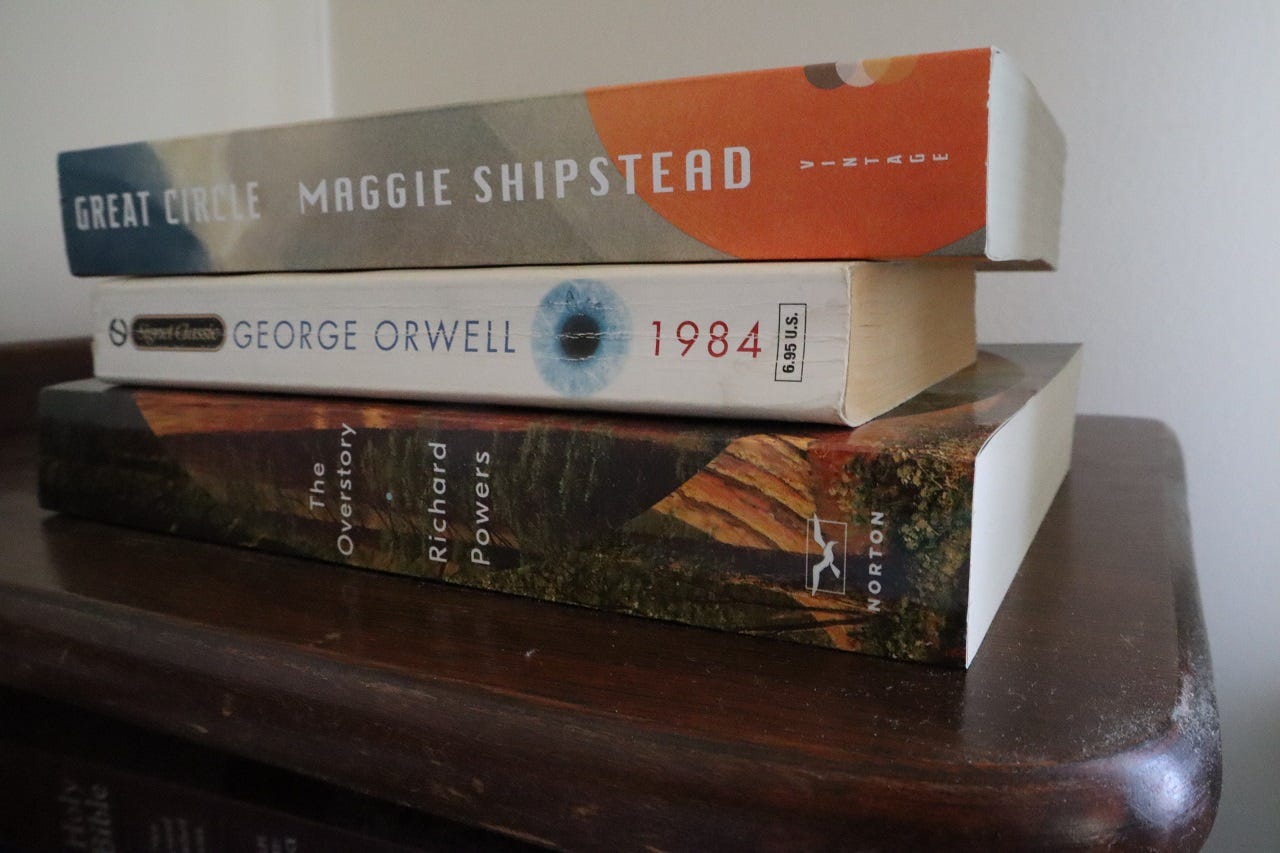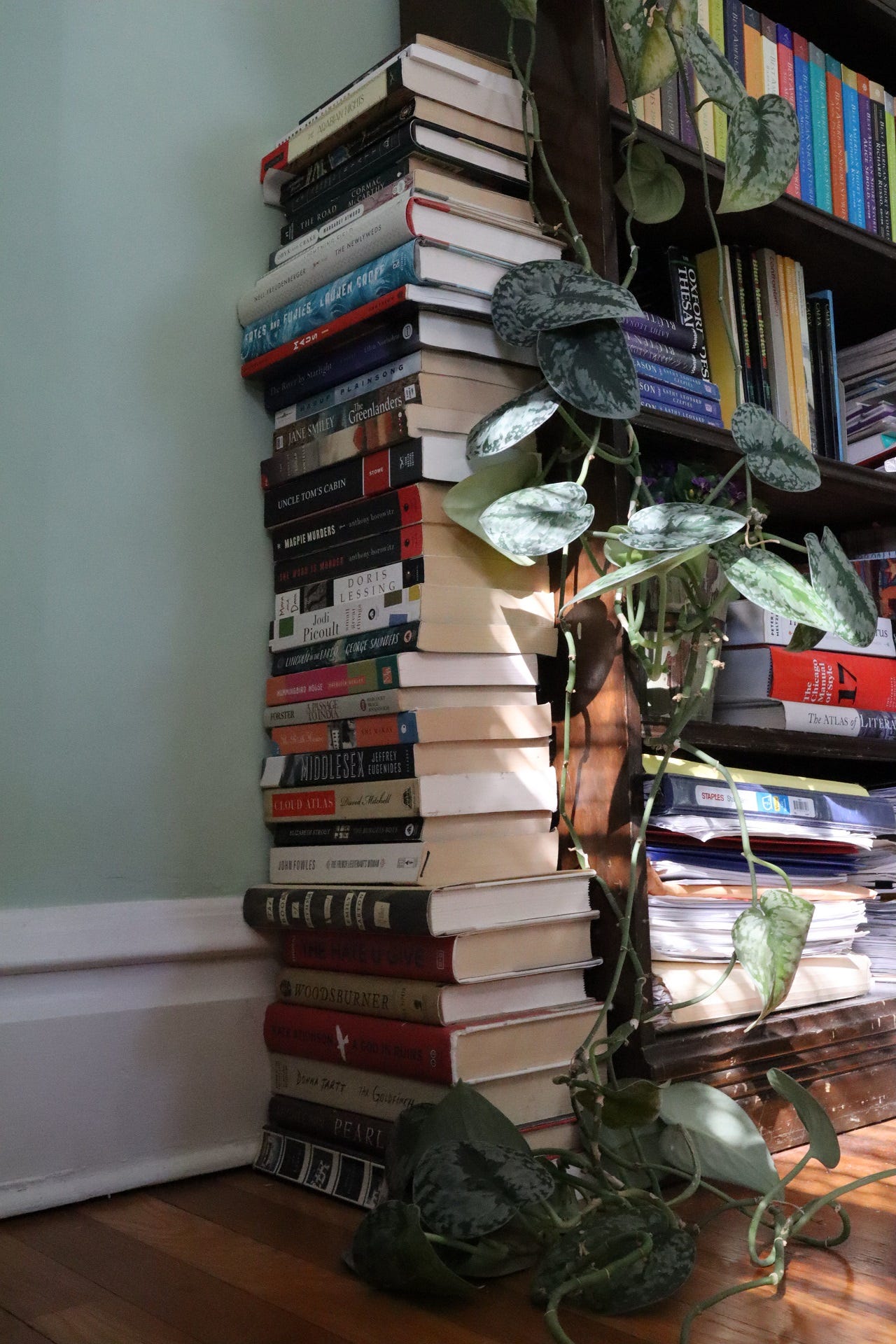If you’re anything like me, a focal point of your home décor is books. Not like the elegant and cozy library behind Alistair Cooke at the opening of Masterpiece Theatre. More like a 20th-century dorm room, because a lifetime of thrift means most of my books are paperbacks I bought new that are now brown-edged like a slice of gently toasted bread or paperbacks I bought used, which often have even less shelf appeal. Nevertheless, I love them.
The problem is, they take up space. Which leads to piles. Which leads to the day when you realize that books, like dust bunnies and cardboard shipping boxes, may be taking over your house.
We were lucky the former owners of our house left behind this hulking oak not-quite-built-in. I’m sure it would have been impossible to move and we, too, will leave it behind someday.
When we moved in 20 years ago, we added a series of shelves under the windows in the adjacent sun room. But all this space still proves inadequate to the task of housing two English teachers, their kids, and everyone’s books, so there are odd little bookcases located in every other room of the house except the bathrooms. I am just now registering that quirky fact. They range from a small cookbook shelf above the refrigerator to a telephone stand that belonged to my grandparents now serving as a bedside bookshelf to a more traditional pair flanking my downstairs desk. (Yes, there is also an upstairs desk.)
And then there are the piles.
A house full of books is something like a garden. Though the books don’t literally multiply like self-seeding plants, they seem to, and they have to be pruned and transplanted and sometimes dug up and given away like tulips and tomatoes. (Actually, tulips notoriously just die off, but more on my garden another day.) If you don’t take care of a house full of books, you’ll find it just as overgrown as a neglected garden, with books piling in the corners and spilling off the shelves.
About a year ago, I decided it was time for a major intervention after actually counting how many books had piled up on the floor next to my bed over time—more than 100. These were the books I was planning to read any day now.
If you have the luxury of a room in your home that you can call a library, with plenty of lovely shelves for all of your books (this is on the imaginary floor plan of my dream home), then you need not read on. For the rest of you, who may relate to my predicament, here are my top tips for getting your books back in control—along with an “after” photo of one of my projects.
Assess the size of each subject. Unless you have that library room, you probably have a hodgepodge of different bookshelves. Sometimes it’s nice to shelve your books in a logical place—cookbooks above the fridge, for example—but if that’s not crucial, figure out where each collection of books fits most efficiently. This bookshelf, which has probably lived in a dozen different places, currently fits below our TV, where it stores DVDs and a few VHS tapes we’re clinging to, plus our small collection of books on art and music. There are also several books that don’t belong here, but they fit on the bottom shelf and I haven’t gotten around to moving them. Maybe you can spot them.
Alphabetize. I don’t care how you do it—author, title—but please, do not organize your books by the color of their jackets. The internet spawned this practice because it’s visually appealing on YouTube thumbnails and Instagram posts, but you will never be able to find your books easily again. Our fiction section is big, so it’s alphabetized by author. The non-fiction is separated by subject, and each section is small enough that we can scan it quickly, so these books are only organized by how they fit on the shelves.
Use bookends. Nothing fancy. Just a humble metal bookend will protect your book bindings by keeping everything upright and square. It will also help keep your shelves tidy. (You will note places where I need to follow this advice.)
Heed the warnings. See, above, the photo of our big oak bookcase as an illustration of what I mean. When you start to pile books on top of books, you have too many books for the shelf. This is bad for their bindings, and it obviously looks messy. Soon, they will also be on the floor. Take this as a signal that it’s time to do a bit of culling. Then…
Cull away! Look for books you aren’t going to read even though you thought you would; doubles (with two English teachers, we continue to find these on our shelves); books you’ve read but don’t feel attached to; books you think a friend would enjoy reading (pass them on!); and even books that actually belong to a friend. All that should be left are books you haven’t read yet but honestly intend to read; books you’ve already read but love so much you want them near you; and books you’ve already read but expect you will need again. (Herein lies the Achilles heel of English teachers and writers because we might need any one of these books someday!)
Sort and prioritize. This is how I finally got control over the 100-plus books in my bedroom floor TBR pile. These books all fell into the “keep” category because I intended to read them.
First, I culled out 15 that I knew I wasn’t going to read after all and took them to the library used bookstore. I separated the rest into fiction and non-fiction.
From the fiction pile, I pulled three that I really wanted to read first and put them in a special “on deck” spot on my telephone table bookshelf. This is my honest TBR pile.
The rule was this: I could swap out one for another, and when I took one out to read, I could replace it with another, but I could not add a fourth book to the pile. This has worked beautifully for more than a year. I don’t have to go rooting around when I want something new to read. It’s also interesting to note how often I swap out rather than read from the pile.
I made a pile of the rest of the fiction and, I’m slightly ashamed to say, discreetly leaned it up against a bookshelf in my study. I still have some work to do.
Then I separated my non-fiction into two piles—what’s good to read at bedtime, and what’s not. This is the subject for another essay, but the gist of it is that at bedtime, I don’t want to read anything that’s going to give me nightmares. Books that won’t are now on my bedside bookshelf, within easy reach, and the rest of the tougher non-fiction got a shelf space of their own in my study. Also at my bedside are neat piles of short fiction and poetry to dip into before sleep.
Writing this essay inspired me to take on one of the problem spots I still have--that oak bookcase that was Exhibit A for heeding the warning signs! Here’s what it looks like now:
Do you have problems with piles of books or overstuffed bookshelves in your home? What tips can you add that will help the rest of us get organized?








